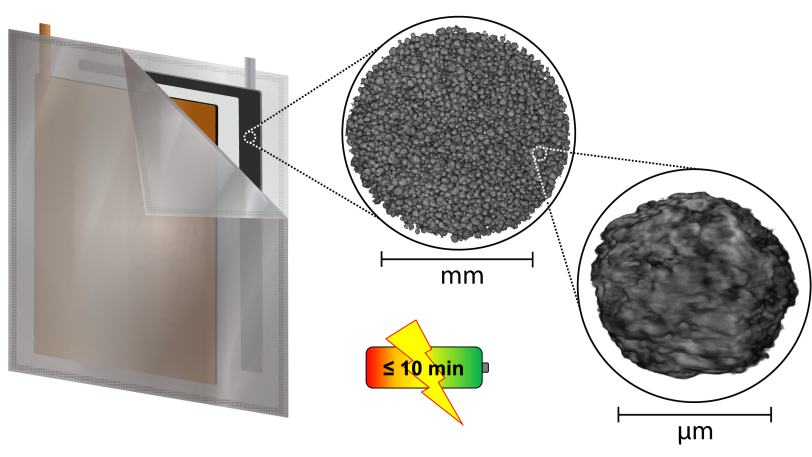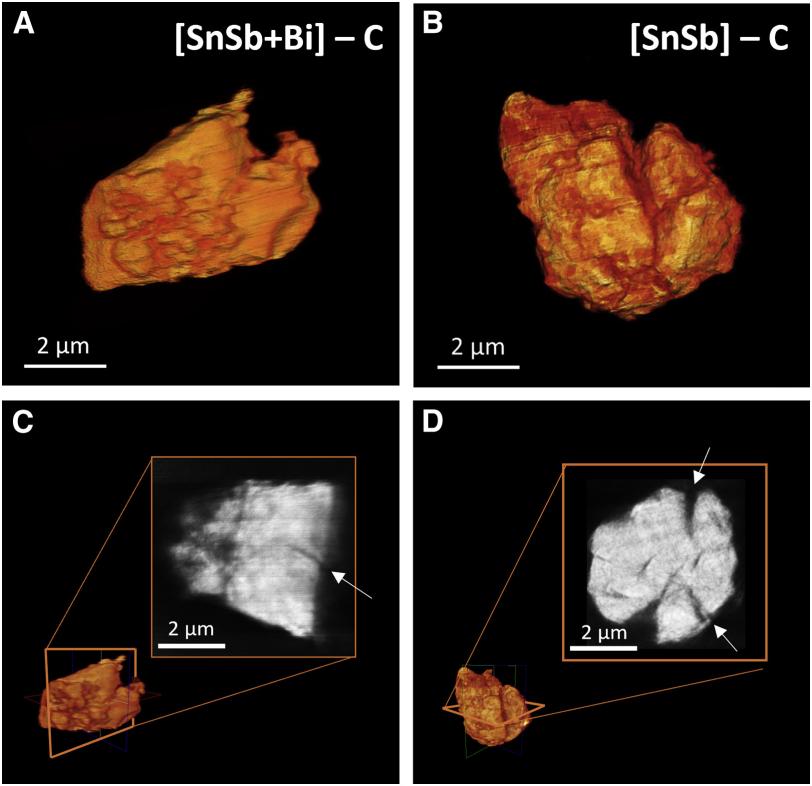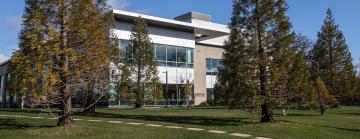Energy Storage
We are using X-ray characterization under realistic operating conditions to understand more completely how rechargeable batteries, such as Li-ion and Na-ion, function and fail. Using different X-ray imaging, spectroscopy, and scattering techniques we can probe batteries from the mm down to Å length scales. Depending on the technique and the questions we want to explore, we can probe full cells in either pouch or cylindrical geometries, half cells, and model cell geometries.

Visualize damage from fast charging at multiple length scales
Fast charging batteries are critical to the widespread adoption of electric vehicles to compete with refueling times of combustion-based vehicles. In the near term, adapting current commercial battery technologies to perform better under fast charging conditions through engineering optimizations will greatly expedite the process while exploratory fast-charging electrode materials are being pursued. To do so, the degradation modes in Li-ion batteries need to be completely explored to understand fast charging limits while maintaining a high energy density and a long cycle life. While lithium plating on graphite still remains a challenge, cathode degradation also plays a key role in battery performance. We used nano- and micro-X-ray computed tomography to characterize the mechanical degradation of cathodes cycled at different rates. Higher charging rates and increased cycling caused the cathode particles to fracture and pulverize, driving cathode capacity fade and contributes to the decrease in overall cell performance.
Primary reference: Molleigh Preefer, Tanvir R. Tanim, Samuel S. Welborn, David N. Agyeman-Budu, Alison R. Dunlop, Stephen E. Trask, Eric J. Dufek, Andrew N. Jansen, Johanna Nelson Weker, "The Evolution of LiNi0.5Mn0.3Co0.2O2 Particle Damage from Fast Charging in Optimized, Full Li-Ion Cells", Journal of Physical Chemistry C, 126 (50) 21196 (2022).

Engineering alloying anodes that don't fracture
Increasing the power density of reusable batteries will allow electric vehicles to travel farther and cell phones and portable electronics to be used longer on a single charge. Scientists are interested in using higher power density lithium alloy materials as the battery anode instead of the commonly used graphite. Although these materials have higher power density, their capacity degrades quickly after a few recharging cycles. This is due to fractures caused by large increases in material volume when charged. Using operando X-ray microscopy we studied how bismuth enrichment causes fracture suppression. Bi-enriched SnSb alloy material form a liquid-like phase between the grain boundaries. X-ray microscopy revealed that this liquid-like phase can reduce the stress caused by volume change during charging by allowing the grains to slide by each other more easily through multiple thermodynamic mechanisms.
Primary reference: Qizhang Yan, Shu-Tin Ko, Andrew Dawson, David Agyeman-Budu, Grace Whang, Yumin Zhao, Mingde Qin, Bruce S. Dunn, Johanna Nelson Weker, Sarah H. Tolbert, Jian Luo, "Thermodynamics-driven interfacial engineering of alloy-type anode materials" Cell Reports Physcial Science, 3 (1) 100694 (2022).

Aqueous Battery Consortium
The Aqueous Battery Consortium pursues the science and engineering for affordable, grid-scale energy storage that will work dependably for a long time. This energy storage device must be more environmentally safe and have a higher energy density than the kind of water-based electrolyte battery in use today. The new aqueous battery should also cost one-tenth as much as today's lithium-ion battery.
The Aqueous Battery Consortium has a total of nine research teams collaborate closely on six major aims and three crosscutting themes.

Center for STrain Optimization for Renewable Energy (STORE)
Through the Center for STrain Optimization for Renewable Energy (STORE) lead by Professor Sarah Tolbert at UCLA, we are using SSRL’s advanced X-ray characterization tools to solve the fundamental materials problems of storing energy with Na-ions. The STORE center, which is a DOE funded Science Foundations for the Energy Earthshot (SFEE), has three routes to understanding and controlling structural change upon insertion of Na-ions into a redox active host matrix. First, we are designing and synthesizing rigid, larger pore tunnel structured materials with a goal of reversibly accommodating large guests like Na+ with minimal structure change. Second, we are understanding glide transitions upon Na+ insertion into layered hosts, with a goal of developing structures and chemistries that can either suppress glide transitions or make them reversible. And finally, we are employing amorphous intermediates that can deform in 3D to mitigate structural degradation through plastic deformation.

Public Lecture—X-rays Reveal Secret Life of Batteries


